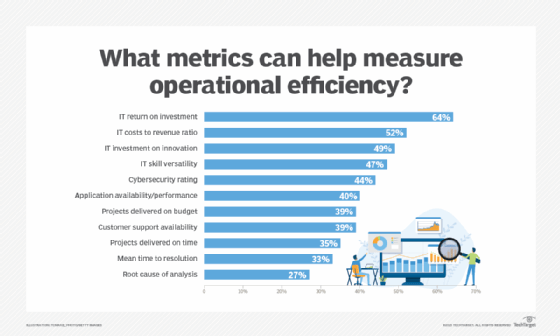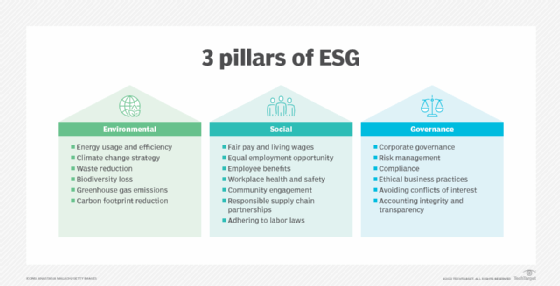operational efficiency (original) (raw)
Operational efficiency refers to an organization's ability to reduce waste of time, effort and material while still producing a high-quality service or product. It's a measure that balances the input -- such as costs, employees and time -- against the output, which includes factors like rapid development times, quality, revenue, customer acquisition and customer retention.
In today's fast-evolving business landscape, operational efficiency transcends traditional boundaries and embraces additional factors such as digital transformation, automation, artificial intelligence (AI) and sustainable practices to create leaner, more agile organizations.
Factors influencing operational efficiency
Operational efficiency requires a company to cost-effectively streamline its base operations while eliminating redundant processes and waste. Most organizations do this by focusing on resource utilization, production, inventory management and distribution.
- Resource utilization aims to minimize waste in production and operations. In the digital and service-oriented economy, minimizing waste extends to optimizing software efficiency, data utilization and virtual services.
- Production focuses on making the production environment as organized as possible. Employees and equipment should work as well as they can to increase production efficiency.
- Distribution ensures efficient handling of the end product, including routing and delivery.
- Inventory management includes producing and managing enough inventory to meet the demand, but with as little excess inventory as possible.
The digital transformation of operational efficiency
The integration of digital technologies has significantly reframed how organizations approach operational efficiency. Automation, AI, cloud computing, business analytics and the internet of things are at the forefront of this transformation.
These technologies streamline processes, enhance data utilization and offer predictive analytics, making operations more responsive and efficient. Agile and lean technologies have expanded beyond manufacturing to influence software development and service delivery, emphasizing flexibility, waste reduction and continuous improvement. Agile methodologies facilitate adaptability and quick response to market changes, while lean methodologies focus on value creation with minimal waste.
How to increase operational efficiency
When asked to improve operational efficiency, a company usually changes its inputs and outputs, such as giving less input for the same output, providing more output for the same input, changing the number of inputs or increasing both input and output. However, different strategies can help improve operational efficiency and often differ from company to company.
Common strategies for improving operational efficiency include the following:
- Monitoring performance by setting up dashboards or internal meetings.
- Identifying and minimizing waste, such as operational bottlenecks. For digital and service-based organizations, cloud computing can enable scalable and flexible resource use, which reduces physical infrastructure waste.
- Creating benchmarks, which can give organizations an idea of where they stand versus their competition.
Using business analytics and machine learning software can optimize operations by predicting trends and automating decision-making processes, thereby reducing time and resource waste.

Metrics organizations can use to measure operational efficiency.
Measuring operational efficiency
To measure operational efficiency, an organization must keep track of its inputs and outputs as performance indicators. Typically, these performance indicators relate to efficiency, quality or value. Examples of this include automation accuracy, quality control indexes and customer satisfaction.
Operational efficiency measurement should also incorporate broader metrics such as sustainability and environmental, social and governance (ESG) considerations.

These are some of the key factors commonly considered in ESG initiatives, which should be taken into consideration when measuring operational efficiency.
The well-being of employees is also crucial. Modern operational efficiency strategies should emphasize mental health, work-life balance, job satisfaction and a supportive work environment. Happy, engaged employees are more productive, contributing to the overall efficiency of operations.
By gathering these indicators into operational and efficiency reports, organizations can see how effectively their company is running and how it handles volume. These reports should also show metrics such as average turnaround time, which can be used to identify performance bottlenecks.
Organizations often prioritize and invest in service and support during difficult times. They need technology that helps improve operational efficiency and retain customers. See how a focus on customer service helps drive customer retention and improve operational efficiency.
This was last updated in May 2024
Continue Reading About operational efficiency
- Designing software for efficient IT operations
- How to improve and optimize a business process, step by step
- Efficiency vs. effectiveness in business: Which comes first?
- The changing role of infrastructure and operations
- AI model optimization: How to do it and why it matters
 Learn how manufacturing data is collected
Learn how manufacturing data is collected  By: Paul Maplesden
By: Paul Maplesden  What is the law of diminishing returns?
What is the law of diminishing returns?  By: Alexander Gillis
By: Alexander Gillis  What is an uninterruptible power supply (UPS)?
What is an uninterruptible power supply (UPS)?  hashing
hashing  By: Kinza Yasar
By: Kinza Yasar